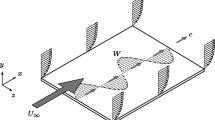Abstract
An experimental investigation of a controllable artificial boundary layer transition by means of electro-acoustic generators was carried out in flat-plate boundary layers. The acoustic generators were flush mounted with the model surface in order to minimize local surface roughnesses which may cause flow instabilities in the laminar boundary layer. The dependence of the input power, pulse ratio, and input frequency of the acoustic generators on the transition threshold values of the input power were determined with surface hot films. In addition, the functional application of the acoustic generators for a controllable artificial boundary layer transition was examined qualitatively by flow visualizations applying the liquid crystal technique.
Similar content being viewed by others
Abbreviations
- A :
-
fluctuating component of the hot film anemometer output voltage
- Ā :
-
time mean hot film anemometer output voltage
- Ā 0 :
-
time mean hot film anemometer output voltage at zero velocity
- B :
-
spectral component of any measured quantity (the used dB-scale is referred to 1 Volt)
- Ē :
-
time mean hot wire anemometer output voltage
- Ē 0 :
-
time mean hot wire anemometer output voltage at zero velocity
- f :
-
frequency
- I av :
-
average input current of the acoustic generator
- P :
-
mean input power of the acoustic generator
- p :
-
pressure
- Re :
-
Reynolds number, Re=U ∞ x t/ν
- t :
-
time
- t i :
-
period of pulse signal
- t p :
-
pulse width of input power
- t s :
-
time after switching off heating lamp
- U ∞ :
-
freestream velocity
- υ :
-
blowing or sucking velocity produced by the acoustic generator
- x :
-
longitudinal coordinate from the leading edge (Fig. 2)
- x t :
-
distance from the flat plate to the transition location
- y :
-
coordinate normal to the wall (Fig. 2)
- z :
-
spanwise coordinate (Fig. 2)
- α :
-
angle of incidence
- γ :
-
pulse ratio t p /t I
- υ :
-
kinematic viscosity
- ϱ :
-
density
- τ 0 :
-
wall shear stress
References
Baumgarten, D.; Kreplin, H.-P.; Wang, Kai-li 1986: Pressure distributions measured on a flat plate with elliptical nose. DLR IB 222-86 A 33
de Bruin, A. C. 1989: The effect of single roughness elements on boundary layer transition in a favourable pressure gradient flow. NLR Technical Report
Corke, T. C.; Mangano, R. A. 1987: Transition of a boundary layer: controlled fundamental subharmonic interactions. Proc. IUTAM symposium on turbulence management and relaminarization. (Eds.: H. W. Liepman & R. Narasimha, Bangalore) 65–88
Goodman, W. L. 1985: Emmons spot forcing for turbulent drag reduction. AIAA J. 23, 155–157
Kegelmann, J. T.; Mueller, T. J. 1984: Experimental studies of spontaneous and forced transition on an axisymmetric body. AIAA Paper 84-0008
Klein, J. 1968: Liquid crystals in aerodynamic testing. J. Astro. Aeron Vol. 6, 70–77
Laster, M. L. 1988: Boundary layer simulation and control in wind tunnels. AGARD Advisory Report No. 224
Li, Jing-bai; Zhou, Ming-de; Meier, H. U. 1987: A preliminary investigation on artificial transition by internal acoustic excitation. DLR IB 222-87 A 14
Li, Jing-bai 1988: Further investigations on artificial boundary layer transition by internal acoustic excitation. DRL IB 222-88 A 37
Liepmann, H. W.; Nosenchuck, D. M. 1982: Active control of laminar-turbulent transition. J. Fluid Mech. 118, 201–204
Maestrello, L. 1985: Active transition fixing and control of the boundary layer in air. AIAA Paper 85-0564
Mangiarotti, R. A.; Bolm, A. J. 1980: Wind tunnel study of acoustical disturbance effect on controlled laminar flow. AIAA 18, 801–807
Meier, H. U.; Zhou, Ming-de 1986: Imposed boundary layer transition by means of heat pulses. Proc. 3rd Asian Congr. Fluid Mech. (Ed.: T. Matsui) 515–519
Meier, H. U. 1976: The response of turbulent layers to small turbulence levels in the free stream. Proc. 10th ICAS Congr., Ottawa, Canada, 88–89
Meier, H. U.; Li, Jung-bai; Maier, A. 1987: Boundary layer transition controlled by flush mounted electro-acoustic generators. DLR IB 222-87 A 33
Meier, H. U.; Zhou, Ming-de 1989: Boundary layer transition controlled by flush mounted electro-acoustic generators. AIAA Paper 89-1005
Reshotko, E. et al. 1987: A proposed boundary layer simulation methodology for wind-tunnel testing. Proc. AGARD FDP symposium on aerodyn. data accuracy and quality requirements and capabilities in wind-tunnel testing, Paper No. 21, Naples
Schöler, H. 1984: The Measurement of heat transfer and temperature distributions in hypersonic testing. DLR IB 222-84 A 09
Schubauer, G. B.; Skramstad, H. K. 1948: Laminar boundary-layer oscillations and transition on a flat plate. NACA Techn. Rep. 909
Wang, Kai-li; Kreplin, H.-P.; Meier, H. U. 1986: Further experiments on artificial boundary layer transition forced by means of heat pulsing. DLR IB 222-86 A 36
Zaman, K. B. M. Q. 1984: Mechanism of broad band jet noise amplification and suppression under controlled excitation. AIAA Paper 84-2319
Zhou, Ming-de; Liu, Tian-shu 1987: Stability investigations in nominally two-dimensional laminar boundary layers by means of heat pulsing. Proc. symp. perspectives in turbulence studies. (Eds.: Meier, H. U., Bradshaw, P.) Berlin Heidelberg New York: Springer
Author information
Authors and Affiliations
Rights and permissions
About this article
Cite this article
Meier, H.U., Zhou, MD. The development of acoustic generators and their application as a boundary layer transition control device. Experiments in Fluids 11, 93–104 (1991). https://doi.org/10.1007/BF00190285
Received:
Issue Date:
DOI: https://doi.org/10.1007/BF00190285




